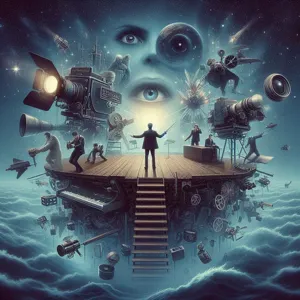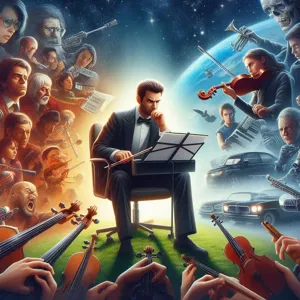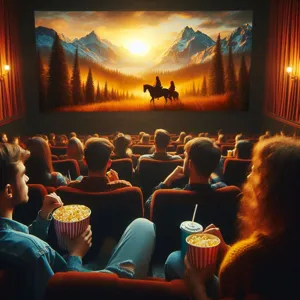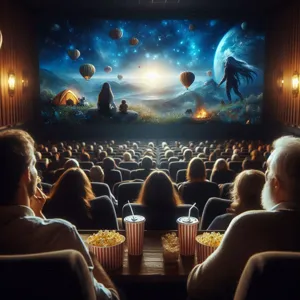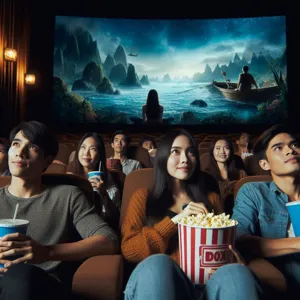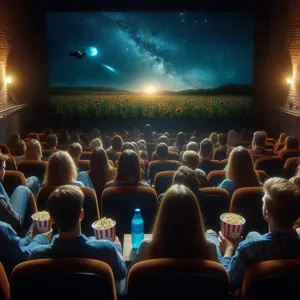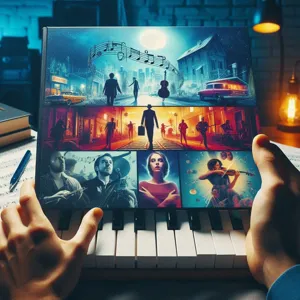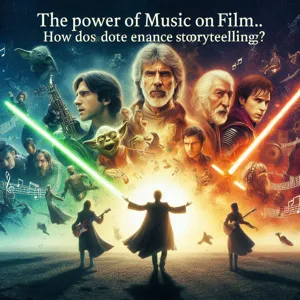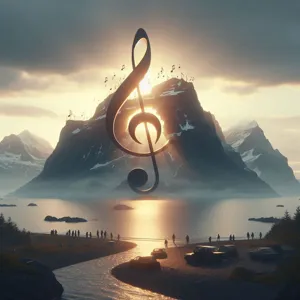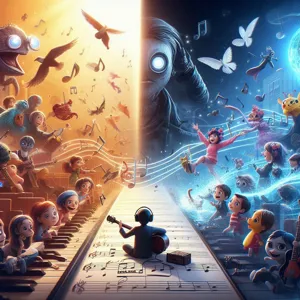Music has an extraordinary ability to resonate with our emotions, shaping our experiences and enriching our lives in profound ways.
In literature, this symbiotic relationship between words and melodies creates a tapestry of narratives that explore the transformative power of music. From the rhythmic prose of celebrated novels to the lyrical poetry that sings of longing and joy, books often serve as a refuge where readers can discover the harmonies that bind us all. In this blog post, we’ll take you on a journey through captivating stories that celebrate music’s role in human connection, healing, and self-discovery. Whether you’re a passionate musician, a devoted reader, or someone seeking inspiration, join us as we explore a selection of literary works that beautifully illustrate how music weaves its magic into the fabric of our lives.
1. Introduction to the Intersection of Music and Literature
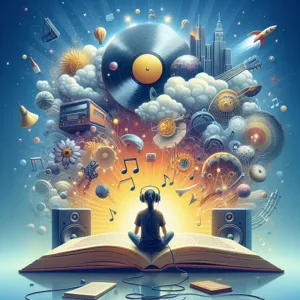
Music and literature have long danced together in a symbiotic relationship, each art form enhancing the other in ways that resonate deeply within the human experience. The melody of a well-structured narrative echoes the rhythm of a symphonic composition, while the poignant lyrics of a song can evoke emotions that linger long after the final note has faded. In this exploration of harmonies in literature, we will delve into the enchanting intersection where music and words converge, illuminating how they collectively shape our perceptions, stir our emotions, and tell our stories.
From the lyrical prose of poets who craft verses that sing to the narrative arcs of novels where characters find solace in their favorite melodies, the influence of music permeates literary works across genres and eras. Writers often draw on musical motifs to enrich their storytelling, imbuing their narratives with a sensory depth that invites readers to not only engage with the plot but to experience the emotional undercurrents that music inherently carries. Moreover, music serves as a powerful backdrop against which characters navigate their lives, grapple with challenges, and celebrate their triumphs.
As we embark on this literary journey, we will uncover books that illuminate the profound role music plays in our lives, illustrating how its rhythms and harmonies can mirror our joys, sorrows, and the complexities of existence. From classic novels that feature the transformative power of melodies to contemporary tales where music serves as a lifeline, these stories not only celebrate the art of sound but also remind us of our shared humanity. Join us as we tune into the narratives that embrace the universal language of music and explore the resonant chords that bind us all.
2. The Historical Relationship Between Music and Storytelling
The interplay between music and storytelling is as old as civilization itself, woven into the very fabric of human culture. From the ancient bards who sang epic tales of heroes and gods to the minstrel performances that graced medieval courts, music has served as a powerful vehicle for narrative expression. Music’s rhythmic patterns and emotive melodies have the unique ability to enhance storytelling, creating an atmosphere that can elevate the reader’s experience and evoke deep emotional responses.
In many cultures, music was used to preserve oral histories, with melodies crafted to help remember the intricate details of a story. The repeated refrains and structured verses allowed storytellers to engage their audience, drawing them into a world where the line between fact and fiction blurred harmoniously. Consider the ancient Greeks, who celebrated the epic poems of Homer, often accompanied by lyres, their verses flowing like melodies that resonated through time.
As we journey through literary history, we find the symbiotic relationship between music and literature flourishing in the works of iconic authors. In the Romantic era, writers like John Keats and Samuel Taylor Coleridge infused their poetry with musicality, creating verses that sang to the soul. Their use of meter, rhyme, and sound patterns not only told stories but also delivered a sensory experience that lingered long after the final line.
In contemporary literature, this relationship continues to thrive. Novels often incorporate playlists or musical references that enhance character development and emotional depth. A character’s favorite song can reflect their inner turmoil or joy, creating a richer, more relatable narrative. For example, in books like “High Fidelity” by Nick Hornby, music is not just a backdrop but a central theme that drives the plot and deepens the exploration of love and loss.
As we explore the historical relationship between music and storytelling, we uncover a profound truth: music is not merely an accompaniment to narrative; it is a powerful force that shapes our understanding of stories and the emotions they evoke. In celebrating this harmonization, we can appreciate how literature and music together resonate with the complexities of the human experience, offering readers a symphony of connection that transcends time and culture.
3. How Music Influences Character Development in Literature
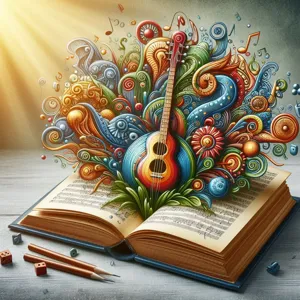
Music has an unparalleled ability to evoke emotions, shape experiences, and create connections, making it a powerful tool in literature for character development. Authors often use music to reveal deeper layers of their characters, providing insights into their personalities, motivations, and emotional landscapes.
Consider how a character’s relationship with music can reflect their inner struggles or transformations. For instance, a protagonist who finds solace in the soothing strains of classical music may be portrayed as introspective and sensitive, while another who is drawn to the rebellious energy of punk rock might embody defiance and a desire for freedom. Through their musical preferences, readers gain a clearer understanding of a character’s identity and the complexities that drive their actions.
Moreover, music often serves as a narrative device that can influence a character’s journey. A scene punctuated by a haunting melody may foreshadow a moment of tragedy or loss, while a lively dance number can signify joy and camaraderie among characters. The rhythm and tempo of the music play a crucial role in setting the emotional tone of these pivotal moments, allowing readers to connect more deeply with the characters’ experiences.
Additionally, music can act as a bridge between characters, fostering relationships and highlighting conflicts. A shared love for a particular genre may draw two characters together, creating bonds that resonate throughout the story. Conversely, differing musical tastes might create tension, illuminating the characters’ contrasting worldviews or backgrounds.
In essence, music in literature is more than just a backdrop; it is a vibrant thread woven into the fabric of character development. It enriches narratives, making the characters more relatable and their journeys more compelling, reminding us of the profound impact music has on our own lives as we navigate our own stories.
4. Exploring Themes of Music in Classic Novels
Music has long served as a powerful motif in literature, weaving its way through the narratives of classic novels to enhance themes, deepen characterizations, and evoke emotions. In this section, we delve into the enchanting world of classic literature, where the subtle strains of melody and lyricism resonate with the very fabric of the story.
Take, for instance, the timeless works of Charles Dickens. In novels like *Oliver Twist*, music is not merely a background element; it reflects the souls of the characters and their struggles. The haunting melodies sung by street urchins provide poignant commentary on poverty and hope, infusing the text with a lyrical quality that lingers in the reader’s mind.
Similarly, in *The Great Gatsby* by F. Scott Fitzgerald, music plays a crucial role in establishing the vibrant atmosphere of the Jazz Age. The opulent parties at Gatsby’s mansion are alive with the sounds of jazz, encapsulating the exuberance and the underlying disillusionment of the era. Fitzgerald’s descriptions of music serve as a backdrop to the characters’ aspirations and heartaches, highlighting the dissonance between their dreams and reality.
The brilliant use of music is also evident in the pages of *Jane Eyre* by Charlotte Brontë. The character of Mr. Rochester often engages with music as a means of expressing his complex emotions. The piano, a symbol of both passion and restraint, becomes a vessel for Jane and Rochester’s evolving relationship, revealing their innermost thoughts and desires in a way that mere words cannot convey.
These examples illustrate how classic novels not only integrate music as a theme but also use it to enrich the narrative and connect with readers on a deeper emotional level. As we explore these works, we uncover the intricate harmonies that exist between music and literature, revealing how the two art forms complement and enhance one another, ultimately celebrating the profound impact of music in our lives.
5. Contemporary Works that Celebrate the Power of Music
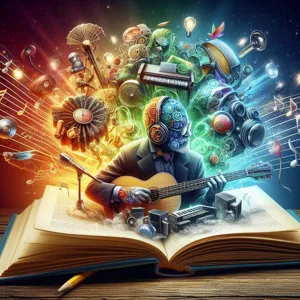
As we delve into the contemporary literary landscape, a rich tapestry of works emerges that not only celebrate music but also explore its profound impact on the human experience. These narratives weave melodies through their plots, illustrating how music shapes identities, fosters connections, and serves as a backdrop to life’s most pivotal moments.
One standout title is *The Music Shop* by Rachel Joyce, a heartwarming tale set in 1988 that transports readers to a quaint vinyl shop on a London street. The story revolves around a quirky cast of characters, each drawn together by their love for music. Joyce masterfully illustrates how music can heal, transform, and bring diverse individuals together, reminding us that the right song can resonate with our innermost selves, offering solace in times of need.
Another compelling read is *An Orchestra of Minorities* by Chigozie Obioma, which intertwines the themes of music and destiny within the life of a young man from Nigeria. The protagonist’s journey is echoed with the rhythm of traditional music, which serves as a powerful narrative device, amplifying the emotional weight of his struggles and aspirations. Through Obioma’s lyrical prose, readers experience how music acts as a cultural anchor, providing a sense of belonging and identity amidst the chaos of modern life.
In *A Visit from the Goon Squad* by Jennifer Egan, the interconnected lives of characters unfold like a symphony, with each chapter exploring different aspects of the music industry. Egan’s inventive storytelling mirrors the dynamic and ever-evolving nature of music itself, highlighting the way it influences relationships and shapes memories. The novel captures the essence of how music is not only an art form but a vital thread that weaves through the fabric of our lives, marking our experiences and memories.
These contemporary works exemplify the myriad ways literature can celebrate music’s intrinsic power. They invite us to reflect on our own relationships with melodies, lyrics, and rhythms, encouraging us to recognize music as a universal language that transcends boundaries and connects us all. Whether through the lens of nostalgia, identity, or the intricacies of human connection, these stories remind us that music is not just an accompaniment to life; it is an integral part of the human experience, deserving of exploration and appreciation.
6. The Role of Music in Setting the Tone and Atmosphere
Music has an unparalleled ability to evoke emotions and create vivid imagery, making it a powerful tool in literature. When authors weave music into their narratives, they often set the tone and atmosphere, enriching the reader’s experience and deepening the connection to the characters and their journeys. From the haunting melodies of a forgotten lullaby to the vibrant rhythms of a lively dance, music can transport readers into the heart of a story, enhancing the mood and inviting them to feel alongside the characters.
Consider the way a gentle piano sonata can soften a tense moment, allowing readers to breathe alongside the protagonist, or how the blaring horns of a jazz ensemble might reflect chaos and urgency during a climactic scene. In works like Toni Morrison’s *Jazz*, the music itself becomes a character, shaping the lives and destinies of those who inhabit its world. Similarly, in *The Music Lesson* by Katharine Weber, the interplay between classical music and the personal struggles of the characters creates an intimate atmosphere that resonates with both beauty and tension.
Authors often use musical references not only to evoke a specific emotional response but also to establish a cultural context that can shape the reader’s understanding of the characters’ backgrounds. A mention of a local folk tune might conjure images of a close-knit community, while a reference to a grand symphony could evoke feelings of aspiration or despair. By integrating music into their stories, writers craft a multi-sensory experience that lingers long after the final page is turned.
Ultimately, the role of music in literature goes beyond mere decoration; it serves as a vital thread that weaves together the narrative, enriching the emotional landscape and leaving an indelible mark on the reader’s heart. Whether it’s the soothing strains of a lullaby or the electrifying pulse of a rock anthem, music in literature celebrates the profound impact that sound and rhythm have on our lives, reminding us of the universal language that binds us all together.
7. Notable Authors Who Incorporate Music into Their Writing
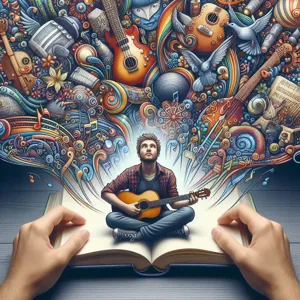
In the realm of literature, music serves as a powerful motif that transcends mere words on a page, often echoing the emotional landscapes of our lives. Several notable authors have woven melodies into their narratives, using music not just as a backdrop but as a vital character that shapes their stories.
One such author is the iconic Toni Morrison, whose lyrical prose often mirrors the rhythms and cadences of jazz. In her novel “Jazz,” Morrison captures the essence of the genre, using its improvisational nature to explore themes of love, loss, and identity. The music becomes a catalyst for her characters’ emotions, inviting readers to feel the pulse of the story in a deeply resonant way.
Another luminary, Haruki Murakami, frequently integrates music into his storytelling, creating a unique ambiance that enhances his surreal narratives. In books like “Norwegian Wood,” Murakami uses songs not only to evoke nostalgia but also to underscore the inner lives of his characters. The playlists he crafts are almost as important as the plot itself, drawing readers into a world where each note carries significance.
Similarly, Nick Hornby’s “High Fidelity” is a love letter to music, exploring the connections between personal relationships and musical preferences. Through his protagonist’s obsession with compiling the perfect mixtape, Hornby delves into the intricacies of heartbreak and self-discovery, illustrating how music can articulate feelings that words alone often fail to capture.
These authors—and many others—remind us that music is more than just entertainment; it’s a universal language that resonates deeply within our souls. By weaving melodies into their narratives, they illuminate the profound ways in which music influences our emotions, relationships, and memories, inviting readers to reflect on the soundtracks of their own lives. Whether it’s the soothing notes of a familiar song or the electrifying beat of a new discovery, these literary works celebrate the power of music in a way that lingers long after the final page is turned.
8. The Impact of Music on Reader Emotion and Engagement
Music has a unique ability to evoke emotions and transport us to different realms of thought and feeling, and this quality extends beautifully into the world of literature. In books that celebrate the power of music, readers often find themselves not only captivated by the narrative but also profoundly moved by the melodic undertones that accompany the characters’ journeys. The impact of music on reader emotion and engagement is more than just a backdrop; it becomes a vital thread that weaves through the fabric of the story, enhancing the overall experience.
Consider novels where music is not just an element but a character in its own right. In these stories, melodies and harmonies reflect the inner turmoil of protagonists, encapsulate fleeting moments of joy, and provide solace in times of despair. The rhythmic cadence of the prose can mirror the beats of a cherished song, creating a symbiotic relationship between the text and the reader’s own emotional landscape.
For instance, in books like *The Music Shop* by Rachel Joyce, the protagonist’s life is intricately intertwined with the music he sells, and each record holds the power to unlock memories and emotions for his customers. As readers follow his journey, they are invited to experience the transformative influence of music firsthand, often finding their own feelings resonating with the notes described on the page.
Moreover, the inclusion of musical references can deepen reader engagement. When a character hums a familiar tune, it can evoke nostalgia or stir a longing within the reader, making them more invested in the narrative. Soundtracks to our literary journeys can come alive in our minds, creating a multisensory experience that enhances our connection to the story.
Ultimately, books that celebrate the power of music do more than entertain; they invite readers to explore their own emotional responses and engage with the narrative in a symphonic embrace. As we turn the pages, we find ourselves not only reading about music but feeling it in our hearts, illustrating the profound impact that this art form can have on our lives and our stories.
9. Analyzing Symbolism: Music as a Metaphor in Literature
In the world of literature, music often serves as a powerful metaphor, transcending mere sound to embody complex emotions, relationships, and societal themes. Authors harness the essence of music to convey deeper meanings, allowing readers to explore the intricate harmonies between life and art. When we delve into the symbolism of music in literature, we find that it becomes not only a backdrop but a central player—a character in its own right.
Consider the poignant use of music in works like F. Scott Fitzgerald’s “The Great Gatsby,” where jazz symbolizes both the exuberance and the disillusionment of the Roaring Twenties. The lively notes echo the dreams and aspirations of Gatsby himself, while also highlighting the hollowness of that era’s pursuit of success. Similarly, in Toni Morrison’s “Song of Solomon,” music serves as a conduit for identity and heritage, connecting characters to their roots and past. The lyrical motifs interwoven throughout the narrative remind us how sound can anchor us to our culture and history.
Moreover, music often represents the emotional landscapes of characters. In novels such as “The Solitary Sound” by Andrew Lam, the act of playing an instrument becomes a metaphor for solitude and longing. The protagonist’s relationship with music mirrors his internal struggles, illustrating how melodies can express what words sometimes fail to convey. It’s in these moments that literature and music intertwine, creating a tapestry of meaning that resonates long after the last page is turned.
As we analyze the symbolism of music in literature, we uncover the universal truths that connect us all. Like a symphony, each book adds its unique voice to the larger narrative of the human experience, reminding us of the profound impact that music has on our lives. Through these literary explorations, we gain a deeper appreciation for both art forms, celebrating their shared ability to evoke emotion and inspire reflection.
10. Music in Poetry: The Rhythm of Words and Melodies
Music and poetry share an intrinsic bond, weaving together rhythm, emotion, and imagery in a way that resonates deeply with the human experience. When we explore the symphony of words crafted by poets, we find that many have harnessed the power of music to amplify their themes, evoke emotions, and paint vivid landscapes within the reader’s mind. In this section, we delve into the enchanting world of poetry where melodies and verses intertwine, creating harmonies that linger long after the last line is read.
Take, for instance, the works of Langston Hughes, whose poetry often echoes the rhythms of jazz and blues, capturing the spirit of African American culture. His verses pulse with the heartbeat of music, using repetition and cadences that mimic song, drawing readers into a vibrant auditory experience. Similarly, the lyrical prowess of John Keats transports us to a realm where nature and music coalesce, as seen in his poem “Ode to a Nightingale,” where the song of the nightingale becomes a metaphor for transcendence and beauty.
Moreover, the modern world of poetry continues to embrace music, with spoken word artists integrating beats and melodies into their performances, transforming the reading experience into a dynamic auditory celebration. The fusion of hip-hop and poetry has given rise to a new generation of poets who craft their words with the rhythm of rap, exploring themes of identity, struggle, and resilience.
As we navigate through the pages of these poetic masterpieces, we discover that music is not merely a backdrop but a vital force that shapes the very essence of the words. It invites us to listen more closely, to feel more deeply, and to understand the profound ways in which music enhances our lives and connects us to one another. In celebrating the rhythm of words and melodies, we uncover the harmonies that exist within literature, reminding us that music, in all its forms, is an integral part of the human story.
11. How Music Enhances Narrative Structure and Flow
Music is more than just a backdrop; it acts as a powerful narrative device that can shape the structure and flow of a story. In literature, the rhythmic cadences of prose can echo the very qualities of musical composition, creating a symbiotic relationship between words and melody. Just as a symphony unfolds through movements that build tension, release, and resolution, so too can a well-crafted narrative engage readers by mirroring these musical principles.
Consider how an author might use varying sentence lengths to mimic the dynamics of a musical composition. Short, staccato sentences can create a sense of urgency or excitement, while longer, flowing sentences might evoke a sense of calm or reflection. This deliberate manipulation of pacing allows the reader to experience the narrative much like a listener experiences a piece of music, guiding their emotional responses and enhancing their connection to the story.
Moreover, the thematic elements of music often intertwine with the plot, enriching the narrative. Books that feature musicians or musical settings often delve into the intricacies of emotion and human experience, exploring how music can serve as a catalyst for character development. For instance, a character’s journey might be punctuated by the songs they compose, reflecting their inner turmoil, growth, or triumph. As readers engage with these musical elements, they are not only drawn into the story but also invited to reflect on their own relationships with music and its power to shape our lives.
In essence, when authors skillfully weave music into their narrative structure, they create a multi-layered reading experience that resonates on both an emotional and intellectual level. This harmony between music and literature enriches the storytelling process, leaving readers with a lasting impression of the profound impact music can have on our lives. Whether it’s through the rhythm of the prose or the thematic exploration of music’s role in the human experience, the interplay of these two art forms can lead to a deeper understanding of both.
12. Recommended Reading List: Books Centered on Music
In the symphony of literature, there exists a vibrant collection of books that not only celebrate music but also explore its profound impact on our lives. Whether you’re a musician, a casual listener, or someone who simply appreciates the art of sound, these recommendations will resonate with you on multiple levels. Each of these titles offers a unique perspective, weaving the essence of music into the narrative fabric of their stories.
1. **”The Music Lesson” by Victor L. Wooten** – This engaging book takes you on a philosophical journey through a music lesson that transcends the ordinary. Wooten, a renowned bassist, shares insights about the relationship between music and life, urging readers to listen deeply and connect with the rhythm of their own existence.
2. **”Just Kids” by Patti Smith** – A poignant memoir by the iconic musician and poet, this book captures the creative pulse of New York City in the late ’60s and ’70s. Through her relationship with photographer Robert Mapplethorpe, Smith intricately weaves themes of art, love, and music, offering a heartfelt tribute to the enduring power of artistic collaboration.
3. **”How Music Works” by David Byrne** – In this thought-provoking exploration, Byrne, the frontman of Talking Heads, delves into the mechanics of music. From the role of culture in shaping sound to the ways in which technology alters our listening experience, Byrne’s insights illuminate the profound connections between music and our everyday lives.
4. **”The Rest Is Noise” by Alex Ross** – This comprehensive history of 20th-century music is not just for musicians but for anyone intrigued by the cultural shifts that music reflects. Ross masterfully narrates the evolution of different genres and styles, highlighting how music has responded to and influenced the political and social landscapes of its time.
5. **”A Visit from the Goon Squad” by Jennifer Egan** – A Pulitzer Prize-winning novel that intricately spans multiple narratives and timelines, Egan’s work explores the intersection of music and human experience. With characters that range from aging punk rockers to ambitious young professionals, the book captures the fleeting nature of time and the lasting impact of melodies on our memories.
6. **”The Song of Achilles” by Madeline Miller** – While not exclusively about music, Miller’s lyrical prose and the emotional cadence of her storytelling evoke the rhythm of ancient Greek poetry. This retelling of the Iliad through the eyes of Patroclus infuses the narrative with a musicality that complements its themes of love, honor, and the tragic beauty of fate.
These selections are just a starting point, inviting readers to delve into worlds where music serves as a backdrop, a catalyst, or a character in its own right. Each book offers a unique harmony of words and melodies, reminding us of the universal language that music speaks to our hearts, shaping our identities and experiences. As you explore these titles, you may find that the rhythms and harmonies within their pages reflect the soundtracks of your own life.
13. The Influence of Music Genres on Literary Themes
Music and literature have long shared a symbiotic relationship, each art form enriching the other in profound ways. The influence of specific music genres on literary themes is a fascinating exploration of how rhythm, melody, and lyricism can shape narrative structure, character development, and emotional resonance in storytelling.
Consider the raw emotion found in blues music, which often conveys themes of hardship, love, and resilience. When infused into literature, these elements can manifest as deep character backstories or poignant moments of reflection. Authors like Zora Neale Hurston and Langston Hughes drew heavily on the blues tradition, weaving its rhythms and themes into their prose and poetry, creating works that resonate with the struggles and triumphs of the human experience.
Similarly, the exuberance of jazz serves as a backdrop for many modern narratives, often symbolizing freedom and spontaneity. In novels like “The Great Gatsby” by F. Scott Fitzgerald, the jazz age encapsulates a period defined by both decadence and disillusionment. The music of the time mirrors the characters’ desires and disillusionments—where the lively syncopations reflect the superficial glamour of the era, while the underlying melancholy hints at the emptiness that lies beneath.
Furthermore, folk music’s storytelling tradition offers another layer of depth to literature. Folk songs often encapsulate cultural history, morality, and communal experiences, making them a powerful influence on authors looking to ground their narratives in a specific time or place. Writers such as Alice Walker and Gabriel García Márquez infuse their works with the essence of folk traditions, illustrating how the collective consciousness of a community can resonate through both song and story.
In contemporary literature, we see genres like hip-hop and pop music shaping narratives that speak to modern societal issues. The lyrical quality of rap, with its intricate wordplay and social commentary, has inspired a new wave of poets and novelists to adopt similar techniques in their writing, amplifying voices that challenge the status quo and reflect the complexities of urban life.
As we delve into the pages of these literary works, we discover that music is not merely a backdrop; it is an integral part of the narrative fabric. The interplay between various music genres and literary themes invites readers to experience stories in new and dynamic ways, reminding us of the universal language of expression that connects us all. Each page turned is a note played, each character developed a melody sung, creating a harmonious blend of sound and story that enriches our understanding of both art forms.
14. Personal Reflections: How Music Shapes Our Understanding of Literature
Music has long been intertwined with the fabric of literature, weaving a complex tapestry that enhances our understanding and appreciation of both forms of art. As readers, our personal reflections on music often influence how we interpret the narratives we encounter. The rhythm of a line can resonate like a melody, while the emotional crescendos of a story may echo the highs and lows of a symphonic masterpiece.
Consider how a particular song can evoke memories or feelings that shape your perception of a character or a theme. When I read a novel layered with musical references, I find myself recalling specific songs that align with the emotions the author conveys. For example, a character grappling with heartbreak may bring to mind a poignant ballad, while a scene of joyous celebration might resonate with an upbeat anthem. This interplay invites a deeper engagement, as the music not only amplifies the text but also personalizes the reading experience.
Moreover, the structure of literature often mirrors the composition of music. Just as a sonata unfolds through its movements, a well-crafted narrative features rising action, climaxes, and resolutions. This parallel offers a unique lens through which to explore themes of rhythm, harmony, and discord within the text. As we delve into stories that celebrate the power of music, we begin to see the world through a dual lens—one that appreciates the beauty of language alongside the emotive power of sound.
In essence, our personal musical experiences shape our understanding of literature, enriching our interpretations and connecting us to characters and plots on a profound level. The next time you pick up a book that celebrates music, consider how your own soundtrack influences your journey through the pages, allowing each note to harmonize with the written word in a symphony of understanding.
15. Conclusion: Embracing the Harmony Between Music and Literature
As we conclude our exploration of the symbiotic relationship between music and literature, it becomes clear that both art forms offer us profound insights into the human experience. Throughout this journey, we have uncovered how authors weave melodies into their narratives, using music not only as a backdrop but as a vital force that drives character development and enhances emotional resonance.
In the pages of these remarkable works, music transcends mere sound; it becomes a language of its own—capable of expressing what words alone often cannot. From the rhythmic pulse of poetry that echoes the beat of a song to the narratives that unfold like a symphony, the bond between music and literature enriches our understanding of both.
As readers, we are invited to immerse ourselves in these harmonies, to feel the cadence of the prose and the lyrical beauty of the verses. These books remind us that music is not just an auditory experience; it is a narrative thread that connects us to our own stories and to one another.
So let us embrace this harmony. Let us pick up a book that resonates with our musical soul, allowing the melodies to dance through our minds, inspiring creativity and reflection. In doing so, we celebrate not only the power of music but also its ability to transcend boundaries and bring us together in a shared appreciation of art. The next time you delve into a story, listen closely—there may be a symphony waiting to be discovered between the lines.
As we conclude our exploration of literature that celebrates the profound impact of music on our lives, we hope you feel inspired to dive into the enchanting worlds crafted by these talented authors. Each book we highlighted serves as a reminder of how music transcends boundaries, evokes emotions, and connects us to our shared humanity. Whether it’s the rhythm of a heartfelt melody or the lyrical prose that resonates within us, these stories invite us to reflect on the melodies that shape our experiences. So, grab a cozy blanket, a cup of your favorite beverage, and immerse yourself in these harmonies of literature. Let the power of music not only enhance your reading experience but also remind you of the beautiful symphony that plays through every moment of your life. Happy reading!


